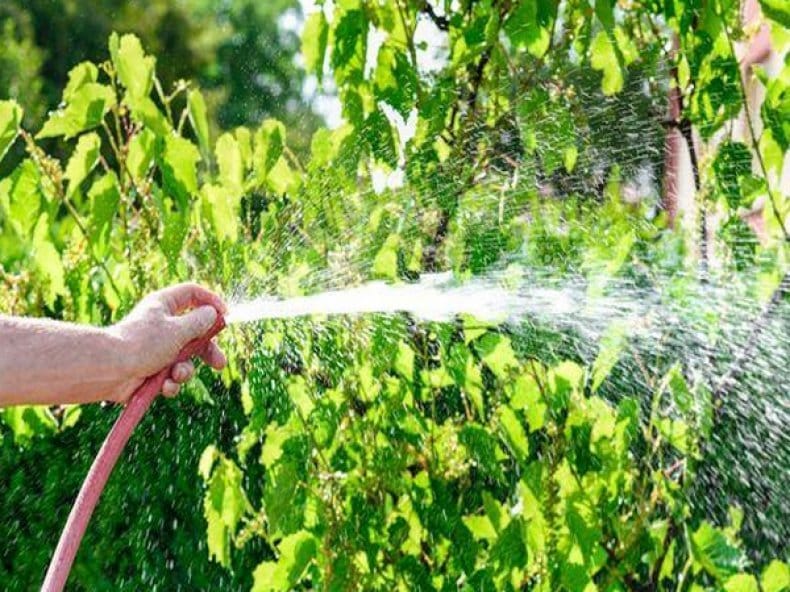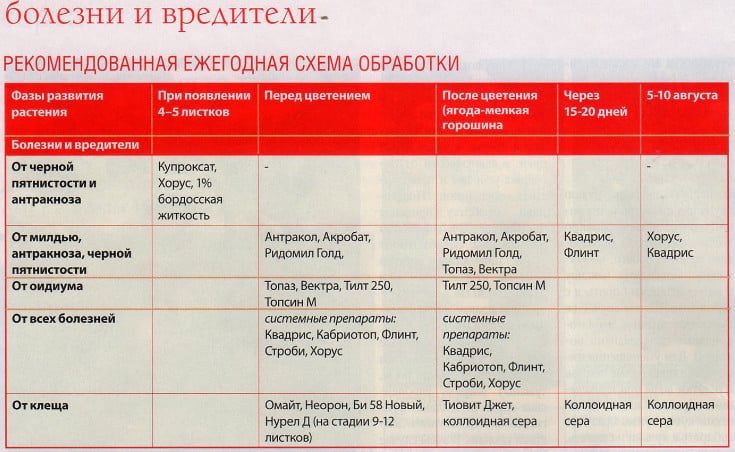What care for grapes is required in June and how to carry it out correctly
Fertilizing, tying up vines, spraying against diseases and pests, pruning, pinching are just some of the activities that are important to carry out regularly when growing vines with juicy, sweet fruits. We'll tell you how to care for grapes in June to get a rich harvest.
Caring for grapes in June

At the beginning of summer, grape bushes actively increase green mass and become heavier. Therefore, overgrown vines are tied to supports, pinched and excess ovaries are removed to prevent shoots from breaking off.
Advice! Pinch out the top clusters on the vines: they are less developed and do not grow as large as the rest.
When the berries grow to the size of a pea, the bushes are sprayed with fungicides (for example, Ridomil Gold or Topaz) to prevent and treat purple spot, oidium, fruit and gray rot, and powdery mildew.
In June, foliar feeding (spraying) with phosphorus-potassium fertilizers, preparations like “Ovary” and other similar means. Such procedures contribute to the active formation of ovaries.
Watering at the beginning of summer is carried out as the soil dries. Young seedlings especially need timely moisture. Usually 1-2 heavy waterings per month are sufficient.
Peculiarities
In summer, it is important to pinch the grapevines in time, otherwise the clusters that have formed will not have time to ripen.
Periodically remove the stepsons that form in the axils of the leaves. If this is not done, the bush will spend energy on the growth of new shoots, and not on the formation of existing stems and ripening of berries.
Attention! Daily inspection of the vineyard will allow you to recognize a developing disease or detect pests in time.
In summer grape pruning they don't do it as such. In June, pinching, pinching and chasing are carried out, and excess vines and leaves that shade the ovaries are periodically removed. These measures allow you to avoid dense bushes, uneven lighting and insufficient ventilation.
The main goals of work in the vineyard in June are to protect the plantings from diseases and pests, tie up the vines and remove excess shoots.
Stages of June care
Let's talk about stages of crop care More details in June.
Pruning shoots

At the end of the month, fruiting vines are pruned so that more nutrients are supplied to the formed berries and they ripen faster. To do this, the ends of the shoots are pinched or cut off after the tendrils, leaving 5 leaves after the second bunch.
The tops of vines that have grown to 2.5 m in length are trimmed. If this is not done, the vine will stretch further and form new clusters.
As a result, the grapes will ripen longer and the fruits will be less sweet. Young shoots growing from a replacement knot are not pinched.
Removing stepchildren
From June to the end of August, all stepsons that appear in the leaf axils are regularly plucked out so that the bush does not waste energy growing unnecessary greenery. The stepson is a lateral shoot that appears in the leaf axil in the main part of the shoot.
Advice! When removing the stepson, leave in its place a stump 1.5–2 cm high.Then a new shoot will no longer appear in this place.
If pinching is not carried out, the bushes become too dense and not enough sunlight reaches the bunches. As a result, the berries become sour. The density of the vineyard leads to the appearance of diseases and the spread of pests.
Watering

Mature grape bushes with a powerful root system practically do not need watering. If the summer turns out to be dry, 1-2 abundant waterings are enough.
Young seedlings do not have a strong enough root system to obtain water at depth. Therefore, they are watered approximately once a week at the rate of 10 liters per plant. After irrigation or rain, the soil is loosened, destroying the dense top layer. At the same time, weeds are pulled out, taking away nutrition from the grapes.
Vaccinations

Some grape varieties are susceptible to disease development and are not frost-resistant. Grafting this type onto a more resistant relative helps correct the situation.
Reference! With the help of grafting, several varieties are grown on one bush, which is convenient if the plot is small and it is not possible to plant a large vineyard.
Grape cuttings are grafted in several ways. In June and July, green cuttings are grafted onto green shoots. Cuttings of the desired variety are cut immediately before the procedure. The tip of the scion is sharpened and inserted into the split on the rootstock.
Immediately after the procedure, the rootstock is watered and hilled. If after 12–14 days new shoots do not appear on the grafted cuttings, the upper part of the rootstock is cut off along with the grafting and the procedure is repeated.
Secrets of successful vaccination:
- for the rootstock, choose a frost-resistant hybrid that is resistant to oidium, mildew and phylloxera;
- cuttings and splitting of the scion are done with a sharp, disinfected instrument;
- Pruning of the rootstock vine is carried out perpendicular to the growth line of the vine.
Feeding
Fertilizer application convenient to combine with watering. Superphosphate, ammonium nitrate, and ammonium sulfate are added to the water intended for grape bushes. The exact dosage is calculated in accordance with the instructions for the drug.
Garter

There are dry and green garter vines. A dry garter is an attachment to trellis last year's vines. It is carried out in the spring or early June, until fresh shoots have grown.
Green garter is the attachment of new green vines to a support. It is carried out several times during the season (each time the shoots grow 20–30 cm).
Rationing of bunches
Rationing of bunches involves removing excess inflorescences. For grape varieties with small sleeves, the inflorescences of the 1st order are removed, for the rest - the inflorescences of the 3rd and 4th orders. The procedure is carried out to improve the quality of the harvest and unload the grapevine.
This is interesting:
How to properly care for grapes in July: what to do, tips for beginning winegrowers
Katarovka
In June and August, catarrh is carried out. This is an agrotechnical technique that involves cutting off the surface roots of the underground part of the vine. If you do not pay attention to this procedure in the first years of the bush’s growth, the surface roots will die when the soil freezes, and in the summer the bush will suffer from a lack of moisture.
Important! Pruning the roots of the upper tier allows for good development of deep heel and intermediate roots.
The roots are removed at the end of June and in August, in the morning.To do this, make a hole about 20 cm deep around the base of the bush and cut off the upper roots with pruners or a sharp knife without leaving stumps. To protect against infections, sections are disinfected with a 3% solution of copper sulfate or 1% boric acid. The hole is covered with earth.
Protection from diseases and pests
A properly selected grape protection scheme allows you to successfully control the development of diseases and the proliferation of pests. Processing carried out in several stages:
- The first spraying is carried out in the spring, when the shoots on early varieties reach a length of 10 cm. Copper-containing and sulfur-containing contact fungicides (for example, “Idol” and “Cumulus”) are used for treatment. They will protect the vineyard from anthracnose, phomopsis, mildew, oidium and mites. Treatment is carried out twice with an interval of 2 weeks.
- After another 2 weeks, they are sprayed again with “Idol” and “Cumulus”, but “Aktara” is already added to protect the grapes from felt and leaf mites.
- The third stage of protection is treatment before flowering. This time they use combination drugs for a complex of diseases.
- The next spraying is carried out after flowering has completed, but no later than 2 weeks after the previous treatment. Use insecticides against pests (for example, “Borey”).
- The next treatment is carried out after another 2 weeks. This time it is good to spray in 2 stages to protect the formed bunches from diseases and pests. First, spray with a mixture of fungicide and insecticide (for example, “Topaz” + “Borey”), and the next day - with a copper-containing fungicide (“Idol” and others).
Further spraying is carried out as necessary at intervals of 2 weeks.
Features of summer care depending on the region
Grapes are a southern plant that requires heat and light. However, the achievements of modern selection make it possible to grow it not only in the Krasnodar Territory, but throughout almost all of Russia, including the middle zone, the Urals and even Siberia.
In central Russia, in particular in the Moscow region and Leningrad region, June grape care does not differ from that described above. The vines are pinched, tied, watered, and protected from diseases and pests.
When growing in the Urals and Siberia, special attention is paid to rationing the ovaries, since the short and not always hot summer does not allow a large number of clusters to ripen.
Advice from experienced winegrowers
Advice from experienced winegrowers will help novice gardeners avoid mistakes when growing grape bushes:
- Before you start pruning, think in advance not only the procedure, but also the shape of the future bush.
- When growing grapes in regions with harsh winters, cover the vines to protect them from freezing during the colder months. In this case, keep the bush standard minimal.
- Remove vines older than 2 years, as they will no longer bear fruit.
- When pruning fruit-bearing vines, leave at least 8 eyes on each of them, as some of them are empty.
Conclusion
Proper care of the vineyard in June is the key to obtaining a harvest of sweet and large berries. Timely pruning, pinching and normalizing of bunches allows you to remove excess greenery and ovaries, and treatment with fungicides and insecticides protects the plantings from the development of diseases and pest invasions.

